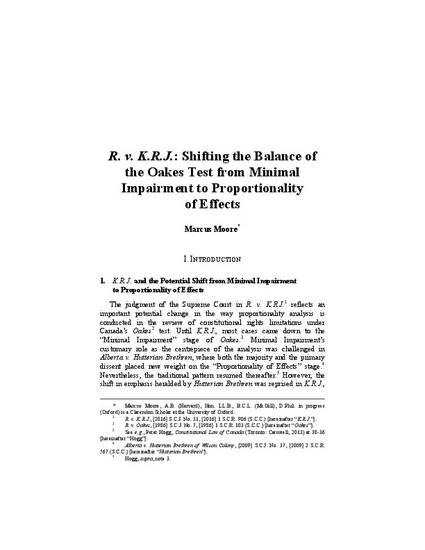
- proportionality,
- Oakes test,
- proportionality test,
- Proportionality of Effects,
- Minimal Impairment,
- Charter of Rights and Freedoms,
- section 1 Canadian Charter,
- Canadian Constitutional Law,
- Supreme Court of Canada,
- R v KRJ
The judgment of the Supreme Court in R. v. K.R.J. reflects an important potential change in the way proportionality analysis is conducted in the review of constitutional rights limitations under Canada’s Oakes test. Previously, most cases came down to the “Minimal Impairment” stage of Oakes. Its dominant role is challenged by KRJ, which places new weight on the subsequent and final “Proportionality of Effects” step. A permanent shift in the focus of the test to the Proportionality of Effects inquiry would be a landmark change in the thirty-year history of proportionality in Canada. The shift does not appear crafted to modify the substantive threshold for justifying rights limitations. Rather, it addresses conceptual issues with the way the test was previously applied. It is apt to accomplish these conceptual goals, enhancing the rationality and conceptual coherence of the justification jurisprudence. Also encompassed by the change, enhanced transparency of proportionality decisions is another benefit when considered in isolation, but is part of a larger issue of the appropriate style of judicial reasoning in Charter adjudication, a longstanding debate that is likely to continue. The potential change raises other important questions. Addressed here are how to understand different formulations of the Proportionality of Effects inquiry, the future division of labour between Minimal Impairment and Proportionality of Effects, and the impact of the change on well-known controversies concerning evidence in justification determinations. While this and other matters remain to be worked out, all in all, KRJ’s shift in emphasis within the Oakes test from Minimal Impairment to Proportionality of Effects constitutes a step in the right direction.
